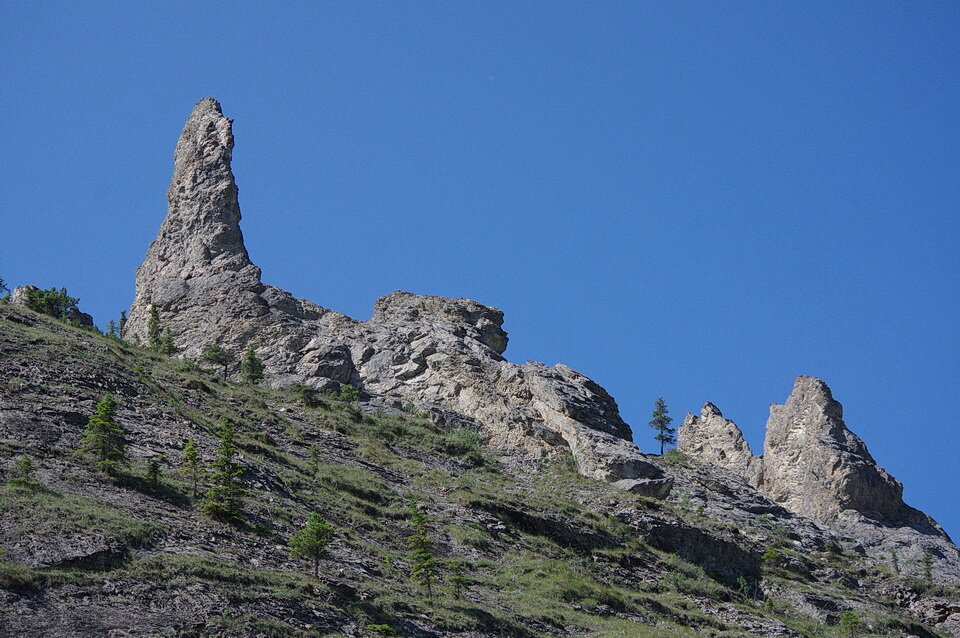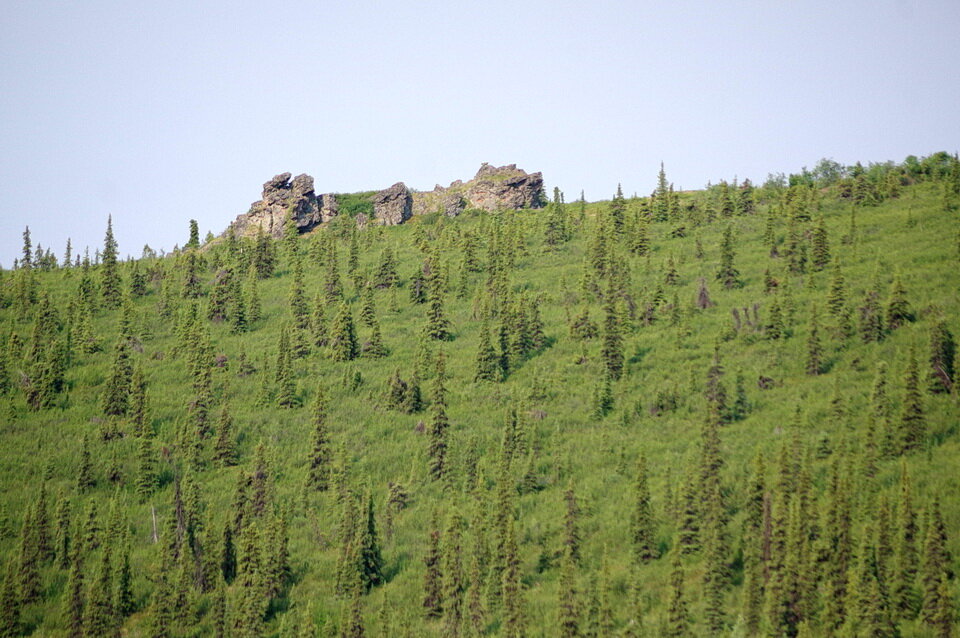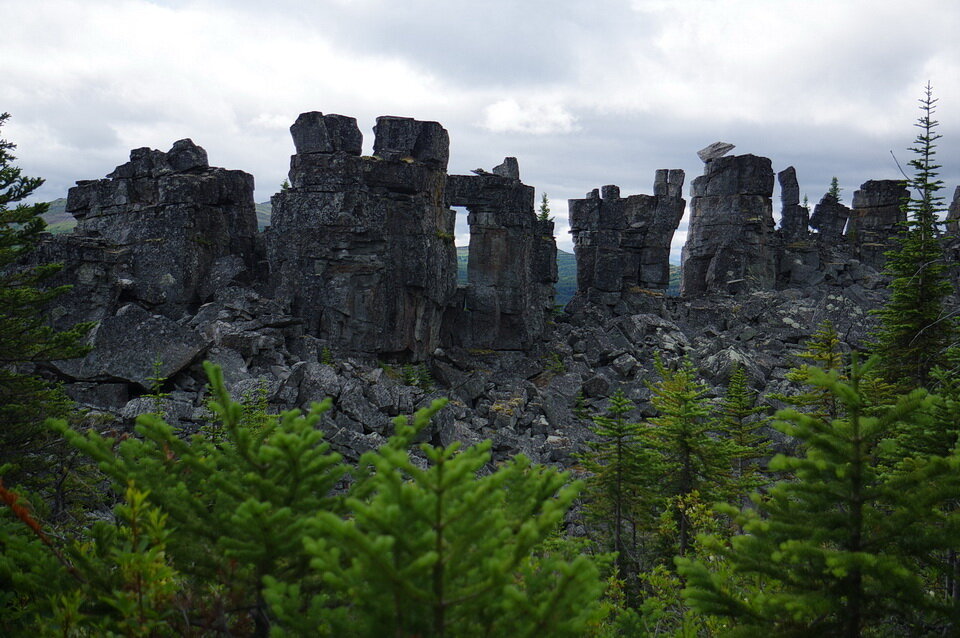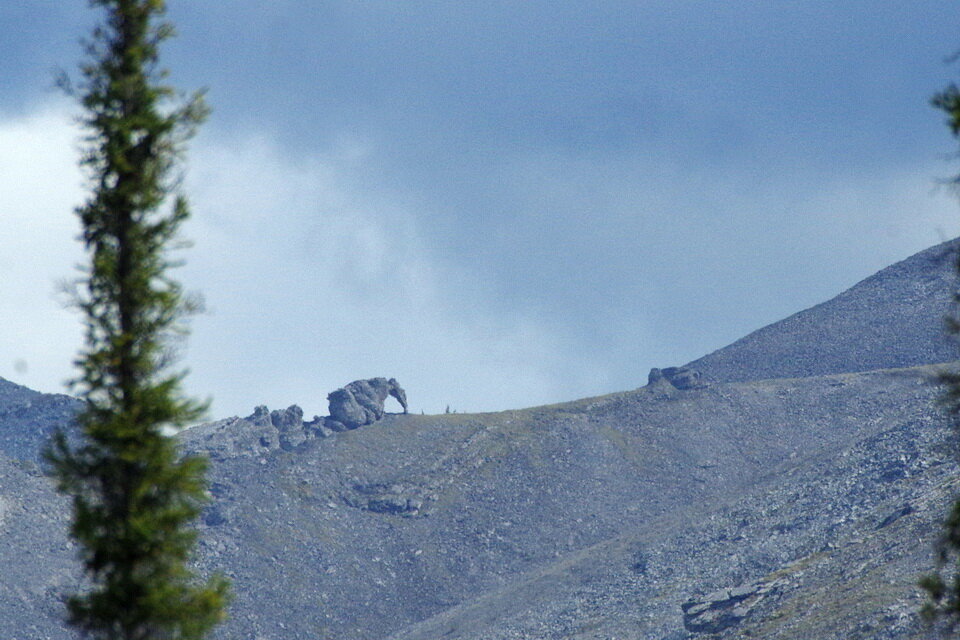Yukon: Alpine Tors, Yukon, Canada
Photo 1: These rock towers are tors. A tor is a large, free-standing rock outcrop that rises sharply from the surrounding smooth and gentle slopes of a rounded hill or ridge crest. The rock consists of limestone. Photo composed by Andy Fyon, along the Ogilvie River area, Dempster Highway, central Yukon, Canada, June 22, 2019.
Tors
A tor is a geological feature. It is a large, free-standing rock outcrop that rises sharply from the surrounding, generally smooth, slopes of a mountain, rounded hill or ridge crest (Photo 1). Tors are thought to have formed when joints, or planes of weakness in the rock, are weathered, material is removed, perhaps by gravity, leaving a central, free-standing block. When many tors exist remain close to each other, they may take on strange or mysterious shapes that can resemble castles (Photo 2), ships or towers (Photos 2 and 3), and even animals (Photo 4).
Photo 2: This tor, located along the Top of the World Highway, northwest of Dawson Creek, Yukon, is informally called Castle Rock because its shape resembles a castle. It also resembles the shape of a ship. The rock consists of metamorphosed sedimentary rock. This area is part of Beringia. Beringia remained ice free and was not glaciated during the last great ice age. This tor exists because neither glaciation nor weathering removed the rock outcrop. Photo composed by Andy Fyon, along the Top of the World Highway, western Yukon, Canada, June 26, 2019.
Photo 3: These tors look like ships, when seen in the distance. For that reason, the hiking trail through this area is called the Shipyard - Titanic Trail, Tumbler Ridge Global Geopark, British Columbia, Canada. The tors are made of sandstone rock. Photo by Andy Fyon, July 28, 2019.
Photo 4: Elephant Rock is a limestone tor that is visible across the Ogilvie River, in the Ogilvie Mountains, central Yukon. The erosion that created this tor is often responsible for the amusing or mysterious animal shape. Photo by Andy Fyon, Ogilvie Mountains, central Yukon, Canada, June 12, 2019.
Tors And Glaciation
Geologists use several features to help determine if, and when, an area was once covered by glacial ice. One clue is the presence, or absence, of prominent, vertical rock features called tors.
The presence of tors in an area is one line of evidence that glaciers did not ravage and scrape the landscape because a glacier would have ground away and removed these tall, free-standing, rock features.
Tors And Ecology
Tors make excellent habitats for birds of prey. Craggy tors provide many ledges suitable for nests. The nests are situated high about the smooth ground below and therefore are protected from ground predators. Crags on a tor also allow a bird of prey to survey the area and to easily take off in flight in search of food. Mountain sheep and goats seek protection on a tor, assured that a hungry grizzly bear won’t sneak up on them. Some plants are adapted to grow in the shelter of tors, where cracks, fractures, and ledges offer a shaded or sunny substrate. Tors are not only spectacular to look at, but they are an essential part of the ecology of an area.
Geological Epilog
Tors formed by weathering and erosion of rocks in areas that were not been glaciated during the last ice age. A tor is an illustration of the hand-holding between geological processes, the ecology of an area, and the appeal to tourists, hikers, and even geologists when seen in the Canada beneath our feet.
Driving Location
Ogilvie Mountains, Yukon: the Ogilvie Mountains, and its tors, are visible in many areas along the Dempster Highway, in central Yukon, Canada. The limestone rock of the Ogilvie Mountains lends itself to the formation of tors. Elephant Rock is visible from the roadside pullout at: 65.54216N and -138.22315W.
Shipyard - Titanic trail, British Columbia: These tors are visible along the Shipyard - Titanic trail, Tumbler Ridge Global Geopark, British Columbia, Canada. The trailhead is located at: 54.92641N -121.00045W.
Have A Question About This Note?
Andy Fyon, June 28, 2020




